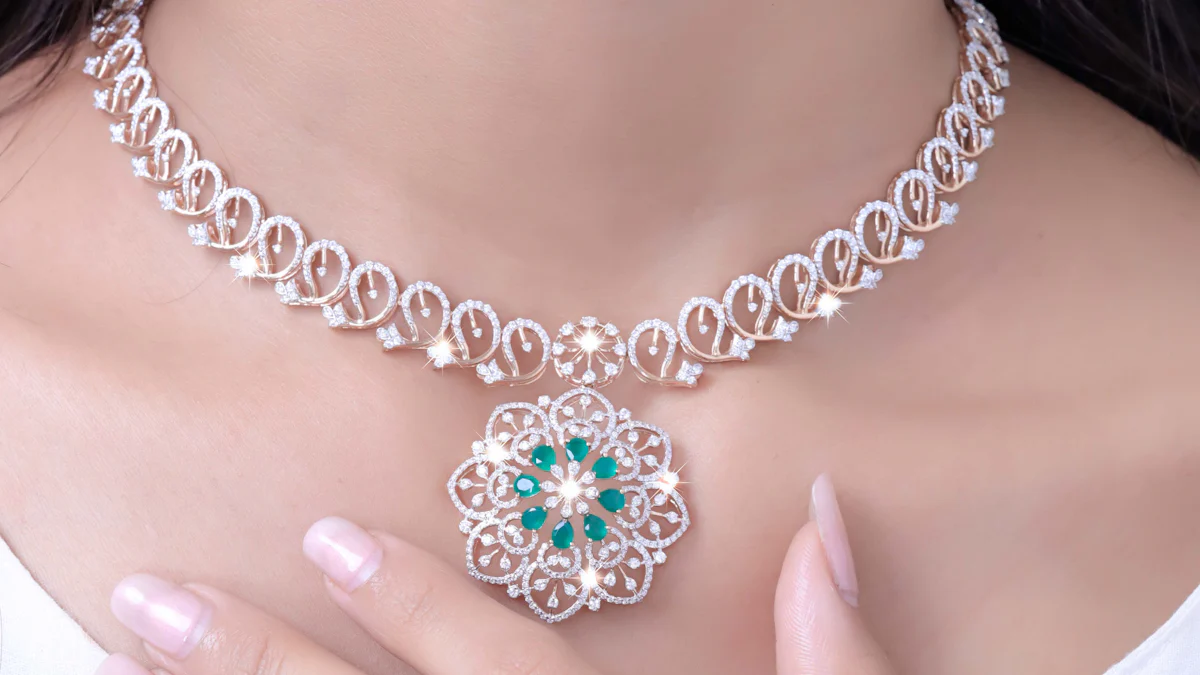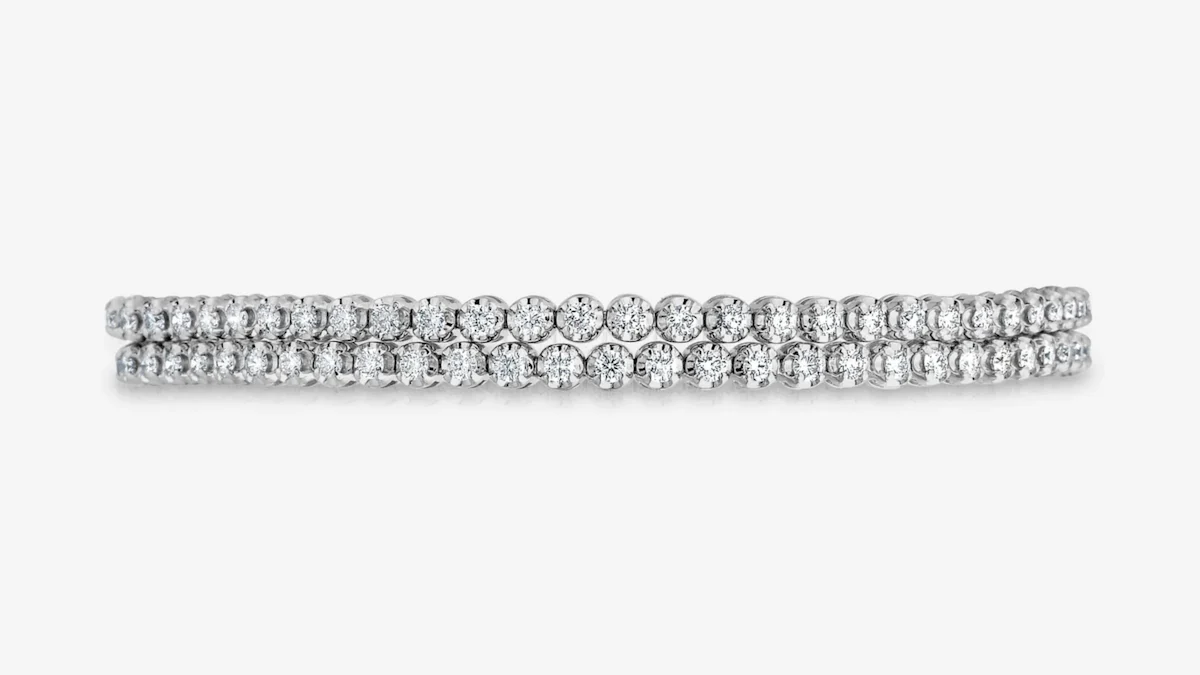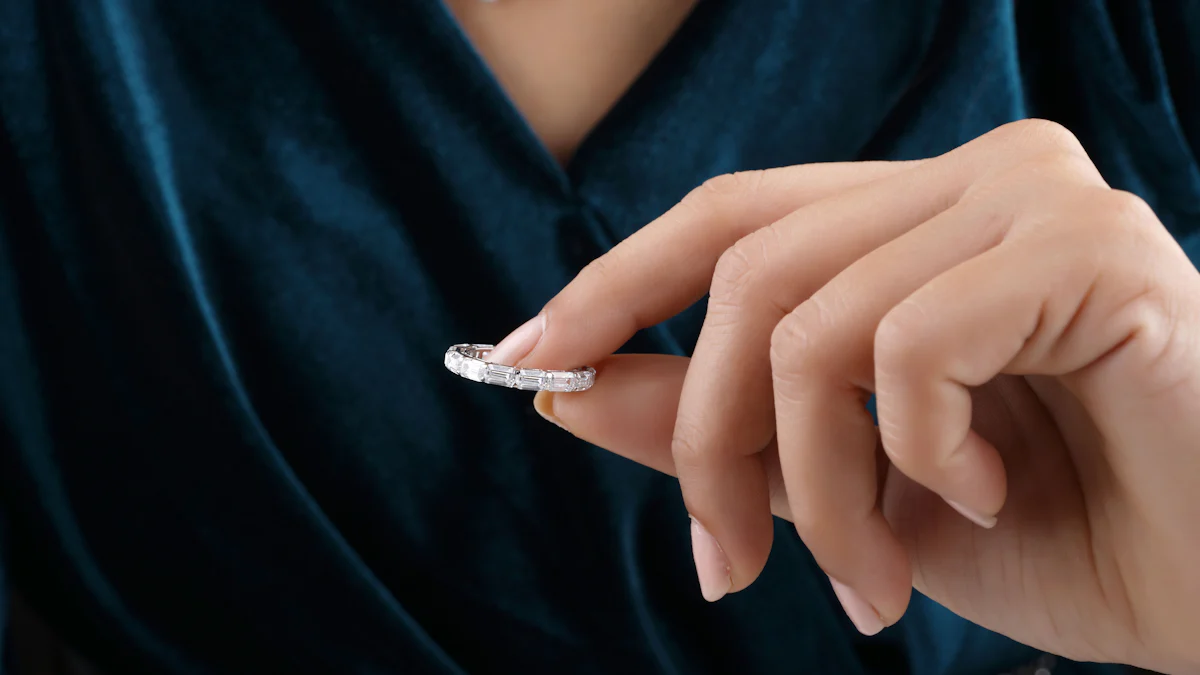What Is CT TW in Jewelry and Why It Matters

Carat Total Weight, often abbreviated as CT TW, represents the combined weight of all diamonds in a jewelry piece. This measurement provides a clear understanding of the total diamond content, helping you evaluate the brilliance and overall appeal of the item. For example, a ring with multiple smaller diamonds totaling 1 carat may look different from a single 1-carat diamond. Knowing what is CT TW in jewelry allows you to make informed decisions, ensuring the piece aligns with your preferences and budget.
What Is CT TW in Jewelry?

Definition of Carat Total Weight
Carat Total Weight, often abbreviated as CT TW or CTTW, represents the combined weight of all diamonds in a piece of jewelry. This measurement includes every diamond, whether it is the centerpiece or part of an intricate design. For example, a ring with ten diamonds, each weighing 0.10 carats, will have a total carat weight of 1.00 carat. However, this calculation excludes non-diamond gemstones and the weight of the metal used in the jewelry.
Understanding what is CT TW in jewelry helps you evaluate the overall diamond content of a piece. It provides clarity when comparing items like a diamond tennis bracelet and a solitaire ring. A bracelet with 15 diamonds, each weighing 0.2 carats, may have the same total carat weight as a ring with a single 3-carat diamond. Despite having identical CT TW, these pieces differ significantly in appearance and value. Knowing this distinction ensures you make informed choices when selecting jewelry.
How CT TW Differs from Diamond Carat Weight
While CT TW measures the total weight of all diamonds in a piece, diamond carat weight refers to the weight of a single diamond. This difference is crucial when assessing the value and design of jewelry. A solitaire ring with one large diamond weighing 2 carats will have a higher individual diamond carat weight than a ring with multiple smaller diamonds totaling 2 carats.
The size and rarity of a single diamond often influence its price more than the combined weight of several smaller stones. For instance, a 1-carat diamond typically costs more than ten diamonds weighing 0.10 carats each, even though both have the same total carat weight. This distinction highlights why understanding both CT TW and diamond carat weight is essential when shopping for jewelry.
"CT TW provides a comprehensive view of the diamond content, while diamond carat weight focuses on the significance of individual stones."
By recognizing these differences, you can better evaluate the design, brilliance, and value of your chosen piece. Whether you prioritize a single striking diamond or a collection of smaller ones, understanding these terms ensures your purchase aligns with your preferences.
How Is CT TW Calculated?
Understanding how CT TW is calculated helps you evaluate the total diamond content in a jewelry piece. This knowledge ensures you can accurately assess the value and appearance of items like rings, bracelets, or earrings. The calculation involves adding the carat weight of each diamond in the piece to determine the total.
The Formula for Calculating CT TW
To calculate CT TW, you simply sum up the carat weight of all diamonds in the jewelry. Each diamond's weight contributes to the total, regardless of its size or placement. For example:
- A ring with three diamonds weighing 0.30 carats, 0.20 carats, and 0.50 carats will have a CT TW of 1.00 carat.
- A pair of earrings with two diamonds, each weighing 0.25 carats, will have a CT TW of 0.50 carats.
This formula applies to all types of diamond jewelry, from necklaces to eternity rings. However, it’s important to note that CT TW only accounts for the diamonds' weight. It does not include the weight of the metal or other gemstones in the piece.
"CT TW provides a cumulative measure of diamond weight, but it doesn’t reflect the quality or size of individual stones."
When shopping for jewelry, you may also encounter terms like "carat weight to millimeter size conversion." This refers to the relationship between a diamond's weight and its physical dimensions. While CT TW focuses on total weight, understanding this conversion can help you visualize the size of individual diamonds in the piece.
Examples of CT TW in Different Jewelry Pieces
Let’s explore how CT TW appears in various types of jewelry:
-
Engagement Rings
A solitaire engagement ring with a single 1-carat diamond has a CT TW of 1.00 carat. In contrast, a halo ring with a 0.70-carat center diamond and 0.30 carats of smaller surrounding diamonds also totals 1.00 carat. Despite having the same CT TW, these rings differ in appearance and design. -
Tennis Bracelets
A tennis bracelet with 20 diamonds, each weighing 0.10 carats, will have a CT TW of 2.00 carats. The uniform distribution of diamonds creates a continuous sparkle, making CT TW a key factor in evaluating the bracelet's brilliance. -
Earrings
A pair of diamond stud earrings with one 0.50-carat diamond in each earring will have a combined CT TW of 1.00 carat. This calculation helps you compare earrings with different designs, such as those featuring multiple smaller diamonds. -
Eternity Rings
Eternity rings often use CT TW to describe the total diamond weight encircling the band. For example, a ring with 15 diamonds, each weighing 0.15 carats, will have a CT TW of 2.25 carats. This measurement highlights the ring's overall sparkle and value.
By examining these examples, you can see how CT TW varies across jewelry types. It serves as a helpful metric for comparing pieces, but remember that factors like diamond quality, cut, and setting also influence the final look and value.
Why CT TW Matters in Jewelry
Understanding what is CT TW in jewelry plays a crucial role in making informed decisions. This metric impacts not only the value of a piece but also its design and suitability for your preferences. Let’s explore why carat total weight matters when evaluating diamond jewelry.
Impact on Jewelry Value
The carat weight of diamonds directly influences the value of a jewelry piece. A higher carat weight often indicates a more valuable item, but the cut quality and overall craftsmanship also play significant roles. For example, a bracelet with a higher carat weight may sparkle more, but poorly cut diamonds can diminish its brilliance.
"CTTW serves as a standardized measure, ensuring consistent evaluation of diamonds, whether lab-created or mined."
When comparing jewelry, you’ll notice that carat weight and cost are closely linked. However, the impact on price depends on factors like the rarity of larger diamonds and the cut quality. A diamond carat guide can help you understand how carat affects price, ensuring you get the best value for your budget.
Influence on Appearance and Design
The carat weight of diamonds significantly shapes the appearance of a jewelry piece. A diamond engagement ring with a single large diamond creates a bold statement, while a ring with multiple smaller diamonds offers intricate sparkle. The cut of each diamond also affects how light reflects, enhancing the overall brilliance.
For instance, a tennis bracelet with evenly distributed diamonds provides a continuous shimmer, while an eternity ring uses carat weight and cut to create a seamless circle of sparkle. Even earrings rely on diamond size and arrangement to achieve balance and elegance. By understanding what is CT TW in jewelry, you can better evaluate how the design aligns with your style.
Importance for Purchasing Decisions
When shopping for jewelry, knowing the four must-knows about carat—weight, cut, quality, and price—helps you make confident choices. CTTW simplifies comparisons by providing a clear picture of the total diamond content. However, you should also consider individual diamond carat weight and cut quality to ensure the piece meets your expectations.
For example, a ring with a 1-carat center diamond and smaller accent stones may have the same total carat weight as a ring with evenly sized diamonds. Yet, the designs differ in appearance and value. Understanding these distinctions ensures you select a piece that matches your preferences and budget.
"CT TW highlights the balance between carat weight and cost, helping you prioritize what matters most—size, quality, or design."
By focusing on ideal cut diamonds and the overall quality of the piece, you can find jewelry that offers both beauty and value. Whether you’re choosing a diamond engagement ring or a pair of earrings, understanding what is CT TW in jewelry ensures your purchase aligns with your needs.
CT TW vs. Diamond Carat Weight: Key Differences

Understanding the distinction between CT TW and diamond carat weight is essential when evaluating jewelry. Both terms describe the weight of diamonds, but they serve different purposes. CT TW refers to the combined weight of all diamonds in a piece, while diamond carat weight focuses on the weight of a single diamond. Knowing when to prioritize one over the other can help you make better purchasing decisions.
When to Prioritize CT TW
You should prioritize CT TW when assessing jewelry with multiple diamonds. This measurement gives you a complete picture of the total diamond content in a piece. For example, a tennis bracelet with 20 diamonds, each weighing 0.10 carats, will have a CT TW of 2.00 carats. This total weight helps you evaluate the overall brilliance and sparkle of the bracelet.
CT TW is also useful when comparing jewelry pieces with similar designs. A halo ring with a 0.70-carat center diamond and 0.30 carats of smaller surrounding diamonds has a CT TW of 1.00 carat. This measurement allows you to compare it to a solitaire ring with a single 1-carat diamond. While both rings have the same CT TW, their designs and appearances differ significantly.
"CT TW provides a comprehensive view of the total diamond weight, making it ideal for evaluating pieces with multiple stones."
When shopping for jewelry, CT TW helps you understand the overall aesthetic appeal of items like eternity rings or diamond-studded earrings. However, remember that CT TW does not account for the quality of individual diamonds. Factors like cut, color, and clarity play a significant role in determining the value and brilliance of the piece.
When Individual Carat Weight Is More Important
Individual diamond carat weight becomes more important when the focus is on a single diamond. This measurement highlights the size and significance of the main stone in a piece of jewelry. For instance, a solitaire engagement ring with a 2-carat diamond emphasizes the beauty and rarity of the single stone. In such cases, the individual carat weight directly influences the value and visual impact of the jewelry.
The quality of the diamond also matters when considering individual carat weight. A well-cut 1-carat diamond can appear more brilliant and valuable than a poorly cut 2-carat diamond. The cut determines how light reflects within the diamond, enhancing its fire and brilliance. This makes the quality of the diamond just as important as its weight.
"A larger diamond with poor cut quality may lack brilliance, while a smaller, well-cut diamond can maximize sparkle and value."
You should prioritize individual carat weight when selecting jewelry where the main diamond serves as the centerpiece. This applies to solitaire rings, pendants, or stud earrings. In these cases, the size and quality of the single diamond take precedence over the combined weight of multiple stones.
By understanding when to focus on CT TW and when to prioritize individual diamond carat weight, you can make informed decisions. Whether you value the collective brilliance of multiple diamonds or the striking presence of a single stone, knowing these differences ensures your jewelry aligns with your preferences and expectations.
Understanding total carat weight (CT TW) equips you with the knowledge to evaluate diamond jewelry effectively. It highlights the combined carat weight of all diamonds in a piece, helping you assess its value and appearance. When shopping, always check the CT TW and compare it with the carat weight of individual diamonds. This ensures you understand the balance between size and design. Pay attention to cut quality and how carat affects price to make informed decisions. Prioritize higher carat weight only when it aligns with your preferences and budget.
FAQ
What does CT TW stand for in jewelry?
CT TW stands for Carat Total Weight. It represents the combined weight of all diamonds in a piece of jewelry, measured in carats. This measurement excludes the weight of non-diamond gemstones and the metal used in the jewelry.
What is the difference between CT TW and ct?
CT TW refers to the total weight of all diamonds in a jewelry piece. On the other hand, ct specifies the weight of a single diamond or gemstone. For example, a ring with multiple diamonds totaling 1 carat would have a CT TW of 1.00, while a single diamond weighing 1 carat would be described as 1 ct.
What does 1/4 CTTW indicate in jewelry?
1/4 CTTW means the total weight of all diamonds in the jewelry equals one-quarter of a carat. This measurement helps you understand the combined diamond content in smaller, intricate designs.
What is the significance of TW, CTW, and CTTW in diamond terminology?
These terms clarify the weight and composition of diamonds in jewelry:
- TW: Total Weight, which can include all gemstones.
- CTW: Carat Total Weight, focusing on the combined weight of diamonds.
- CTTW: Carat Total Diamond Weight, specifically referring to the total weight of diamonds only.
These metrics help you evaluate the value and design of a jewelry piece.
How are gemstones measured in jewelry?
Gemstones, including diamonds, are measured by weight in carats. When multiple gemstones are present, their combined weight is referred to as Total Carat Weight (CT TW) or simply Total Weight (TW). This measurement provides a clear understanding of the overall gemstone content.
What does CTTW refer to in jewelry?
CTTW, or Carat Total Diamond Weight, represents the combined weight of all diamonds in a specific jewelry piece. It gives you an accurate measure of the total diamond content, helping you assess the brilliance and value of the item.
Does CT TW affect the size of diamonds?
CT TW measures weight, not size. Two diamonds with the same carat weight can differ in size due to variations in cut and shape. For example, a well-cut diamond may appear larger than a poorly cut one of the same weight.
Why is CT TW important when buying jewelry?
CT TW helps you evaluate the total diamond content in a piece of jewelry. It allows you to compare items with multiple diamonds, ensuring you understand the overall value and appearance. However, you should also consider the quality of individual diamonds, such as their cut, clarity, and color.
Can CT TW include non-diamond gemstones?
No, CT TW specifically refers to the total weight of diamonds in a jewelry piece. The weight of non-diamond gemstones is measured separately and does not contribute to the CT TW calculation.
How does CT TW influence the price of jewelry?
CT TW impacts the price by reflecting the total diamond weight. Jewelry with a higher CT TW often costs more due to the increased diamond content. However, factors like diamond quality, rarity, and craftsmanship also play a significant role in determining the final price.
See Also
Comparing Tungsten Diamond Rings With Traditional Options
Thorough Analysis of 5 Carat Lab Grown Tennis Bracelet
The Importance of Three Stone Diamond Rings Explained

